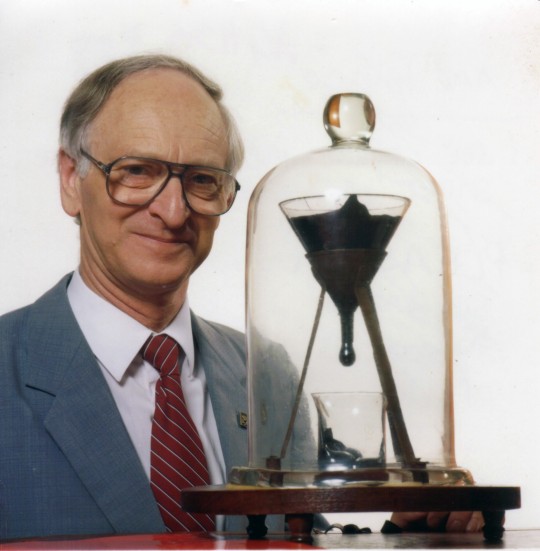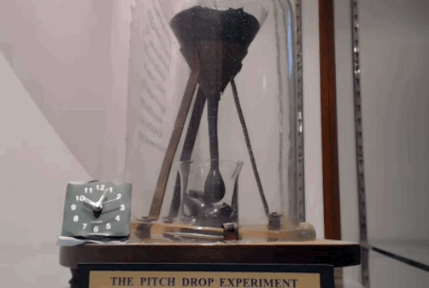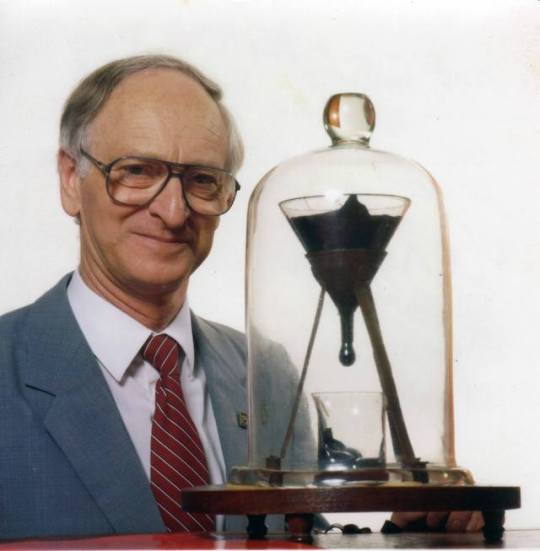#john mainstone
Text
Okay, so here’s the pitch.

#science#physics#university of queensland pitch drop experiment#pitch drop experiment#john mainstone#wordplay#puns
28K notes
·
View notes
Photo







John Piper’s Brighton Aquatints
Further info
28 notes
·
View notes
Text
The world's longest-running lab experiment

The Pitch Drop Experiment
The experiment demonstrates the fluidity and high viscosity of pitch, a derivative of tar that is the world's thickest known fluid and was once used for waterproofing boats.
Thomas Parnell, UQ's first Professor of Physics, created the experiment in 1927 to illustrate that everyday materials can exhibit quite surprising properties.
At room temperature pitch feels solid - even brittle - and can easily be shattered with a hammer. But, in fact, at room temperature the substance - which is 100 billion times more viscous than water - is actually fluid.

In 1927 Professor Parnell heated a sample of pitch and poured it into a glass funnel with a sealed stem. He allowed the pitch to cool and settle for three years, and then in 1930 he cut the funnel's stem.
Since then, the pitch has slowly dripped out of the funnel - so slowly that it took eight years for the first drop to fall, and more than 40 years for another five to follow.
Now, 87 years after the funnel was cut, only nine drops have fallen - the last drop fell in April 2014 and we expect the next one to fall sometime in the 2020s.
The experiment was set up as a demonstration and is not kept under special environmental conditions - it's kept in a display cabinet - so the rate of flow of the pitch varies with seasonal changes in temperature.
The late Professor John Mainstone became the experiment's second custodian in 1961. He looked after the experiment for 52 years but, like his predecessor Professor Parnell, he passed away before seeing a drop fall.
In the 86 years that the pitch has been dripping, various glitches have prevented anyone from seeing a drop fall.
- University of Queensland, Australia

126K notes
·
View notes
Photo

Dropping Pitch This is one of the longest-running experiments in science,
In 1927 at the University of Queensland, a bottle was set up containing pitch; a substance produced during the refining of coal, also called asphalt. In 1930, Professor Thomas Parnell cut an opening in the glass, allowing the substance to move under the influence of gravity. Pitch is a solid, it can easily be shattered with a hammer and won’t move if you sit it on your desk or make a road partially out of it, but given enough time it is able to flow.
Once the container was opened, the pitch began slowly moving downwards. That experiment is recognized as the world’s longest-running scientific experiment, with droplets taking almost a decade to fall. In 2014, the 9th droplet formed from this experiment touched the bottom of the container, starting the process over again. To maintain the experiment, the beaker at the bottom was changed out after that 9th drop, creating space for droplets to fall for perhaps the next century.
This experiment demonstrates a property key in geology; the viscosity of solid materials. Pitch has a viscosity about 1000000000000 times that of water; on the timescale of minutes, hours, or days it appears solid, but on the timescale of decades it is able to flow. The solid Earth works much the same way. The minerals of the Earth are solid, able to fracture if impacted, but they’re also hot and under pressure deep in the planet. These conditions allow the Earth itself to flow much like the pitch does. The viscosity of the Earth is even higher than that of pitch; maybe up to 1000000000 times higher in some places, but just like the pitch, the rocks flow slowly under the force of gravity, allowing parts of the Earth’s surface to slide along and allowing minerals in the mantle to sink and rise. The motion is nearly imperceptible, rates are comparable to the growth-rate of your fingernails, but over geologic time, the results can literally reshape the planet.
This experiment is monitored by webcams and the beaker displaying the previous drops now sits in their view. The scientist pictured is Professor John Mainstone, who was in charge of the experiment for several decades. The experiment is currently under the control of Professor Andrew White, the 3rd custodian of the experiment.
-JBB
Image credit: http://en.wikipedia.org/wiki/File:Pitch_drop_experiment_with_John_Mainstone.jpg Webcams:http://smp.uq.edu.au/content/pitch-drop-experiment Time lapse video:https://www.youtube.com/watch?v=UZKZF7FNh_0&feature=youtu.be Read more:
http://www.newser.com/story/185539/big-news-in-worlds-longest-experiment.html
http://www.uq.edu.au/news/article/2014/04/pitch-drop-experiment-enters-exciting-new-era
http://boingboing.net/2014/05/07/pitch-drop-experiments-scienc.html
1K notes
·
View notes
Text

After months and months of doing almost nothing (which, fair), my dear Lithops marmorata (or maybe amicorum?) has decided to surprise me. Wish it’d waited until I knew I could be home to see it when open, but I guess it’s payback for all the times I’ve made light of the late Dr. John Mainstone. It would serve me right.
8 notes
·
View notes
Text
Infinitely Slowly
John Mainstone, of the University of Queensland, photographed in 1990 with the pitch drop experiment
1988:For half a century, John Mainstone oversaw the University of Queensland’s pitch drop experiment, in which pitch – the tarry substance used to make boat seams watertight – dripped infinitely slowly from a funnel into a flask. Set up in 1927, the experiment demonstrated that pitch is not a…
View On WordPress
#1927#1979#1988#Australia#Cup of Tea#John Mainstone#Pitch#Pitch Drop Experiment#University of Queensland
0 notes
Text
The Most Disappointing Experiment Ever...
In 1927 Professor Thomas Parnell of the University of Queensland started what is known as the longest continuous laboratory experiment in history.
The pitch drop experiment.

He wanted to prove to his students that bitumen, although it has the appearance of a solid, is, in fact, a highly viscous liquid. So he filled a funnel with some hot asphalt and waited 3 years to let it stabilize and subsequently opened the funnel.
And he waited and waited
And waited.
Very, very slowly a drop was forming…
And waited.
After waiting for more than 8 years the first drop fell.
Unfortunately, nobody saw it, so the professor waited for the second drop.
And waited.
When the prof died in 1948 the second drop was completed, but he never saw a drop fall. His successor, Professor John Mainstone, was determined to be the first person that actually would see a drop fall.
With the emergence of new technology, he installed a webcam to make sure the event was recorded, but due to an unfortunate power failure, the camera did not record the occurrence when, in November 2000, the eighth drop fell.
Prof Mainstone died in 2013.
Needless to say that the next prof, Andrew White, was even more determined to see, or at least record, the next drop. A time-lapse camera was set up, with continuous video of the four most recent days, and two additional video cameras. Nothing was left to a chance.
On 17 April 2014, the 9th drop was about to fall: The drop touched the previous drops that were still in the beaker below the experiment, but it was still attached to the funnel. The previous drops were supporting the drop and it wasn't gonna fall.
Prof White decided to put an empty beaker below the experiment to make room for the drop. He carefully lifted the bell jar that protected the experiment. But he didn't know that there was a degraded seal between the glass bell jar and the wooden platform below the experiment. The wooden base wobbled and disaster struck: the 9th drop came loose.
We are now 2018, more than 90 years after the start of the experiment and nobody ever witnessed or recorded a drop.
It really must be the most unfortunate experiment in history.
Peace!
0 notes
Text
Book of the Day #232

John Piper’s Brighton Aquatints, 2019, Alan Powers for the Mainstone Press, Norwich, UK.
https://www.theguardian.com/film/2008/aug/04/1
0 notes
Text
John Minton: Drawn from Life

Published by The Mainstone Press in the centenary year of John Minton’s birth, Martin Salisbury’s new book collects together the artist’s illustrations and cover designs for books, magazines and journals, placing them alongside a host of lesser-known projects for ad agencies, publishers, theatre producers and wallpaper manufacturers.
Minton was a prolific artist, yet his working life actually…
View On WordPress
0 notes
Text
New Post has been published on PBF House Painters
New Post has been published on http://www.pbfhousepainters.co.nz/pbf-paints-remueras-oldest-home/
PBF Paints Remuera's oldest home
We recently had the honour of re-painting one the oldest homes in Remuera.
Mainston Mansion was built in 1853 by the then soon to be superintendent of Auckland Mr Robert Graham.
Mr Graham was born in Glasgow Scotland in 1820 fifth so of a farmer and coalmine owner. After coming to New Zealand at age 20 he and his brother founded businesses in Russel and in Auckland later buying and buying land in Waiwera.
Mr Graham purchased the 500 acres on which it stood between Remuera Rd and Panmure Rd, including Saint Johns. He founded Ellerslie and sold the land that is now the Ellerslie race course.
Interestingly Ladies Mile was likely named as being the route Lady Graham took on her way to the races.
Mr Graham is was one of New Zealand’s most remarkable statesman of that era with many historical contributions to the greater Auckland region and beyond.
Mr Graham was well regarded by local Maori and was know to have negotiated a peace treaty between Maori from Taupo and Rotorua. Both groups later gifted Graham large parcels of land in gratitude for his negotiations.
Courtesy of;
The story Graham Robert. Te Ara Encyclopedia of New Zealand
Cruickshank, G. Robert Graham. Wellington, 1940
The Cyclopedia of New Zealand. Vol. 2. Christchurch, 1902
0 notes
Text
Was hat Gott mir dir bekommen? (TDW 39/2017)
Lesedauer: 6min
Nicht mein Wille, sondern dein Wille geschehe
Lies bitte zuerst: Lukas 22, 39-43
Hey du,
kennst du das? Du denkst: "Das ist gut, das muss ich jetzt tun!" Und dann fängst du an, und merkst, dass es irgendwie überhaupt nicht so läuft wie gedacht. Ich hatte einmal den Eindruck, ich solle mit einen guten Freund von Jesus erzählen. In meinen Vorstellungen ist er vor mir in Tränen ausgebrochen, hat mir die ganze Liste seiner Sünden gebeichtet. Natürlich mit der Aufnahme von Jesus in sein Leben im Anschluss an die total bewegende Szene. Tatsächlich hat er mir zwar zugehört aber das wars auch schon. Irgendwie hatte ich gehofft das könnte so eine krasse Person-bricht-in-Tränen-aus-Story werden und insgeheim hoffe ich, dass er in vielen Jahren völlig unverhofft bei mir klingelt und sich aus tiefstem Herzen bei mir bedankt, dass ich ihm Jesus vorgestellt habe.
Aber ich glaube, die Stimme, die ich da gehört habe, war nicht die von Gott, sondern einfach die "Lass und ne tolle Story kreieren"-Stimme von mir. Und die ist eigentlich nie wirklich erfolgreich.
Pech gehabt
Ich glaube, dass wir im Leben so viele Dinge tun, einfach weil wir sie können, aber Gott ist nicht dahinter. Du kannst dein Leben lang gute Dinge tun und du wirst damit nichts erreichen, wenn es nicht Gottes Wille ist.
Es gab einmal einen Forscher, der hat sein halbes Leben der Pechforschung gewidmet. Pech war damals eigentlich ein Feststoff, aber wollte beweisen, dass Pech eigentlich flüssig ist. Also hat er Pech auf ein Stück Holz gestrichen und wollte beweisen, dass Pechtropfen entstehen und sie studieren. 1927 wurde der Versuch gestartet, und vor 4 Jahren ist John Mainstone gestorben ohne in seinem ganzen Leben auch nur einen einzigen Pechtropfen gesehen zu haben, weil Pech so zähflüssig ist, dass nur etwa alle 10 Jahre Tropfen entstehen. Er hat sein Leben darin investiert, einen Pechtropfen fallen zu sehen und während des Experiments sind drei Tropfen gefallen, aber keinen einzigen davon hat er gesehen, weil er immer kurz mal nicht da war. Pech.
Und ich will dich heute fragen: In was investierst du dein Leben? Wir haben ein Leben hier auf der Erde und deshalb ist es so wichtig sich zu fragen: Lohnt sich das, was ich mache? Ist es Gottes Wille? Egal, ob ich es kann oder nicht kann, denn wenn es Gottes Wille ist, wird er mich dafür ausrüsten. "Gott ist es dein Wille, dass ich das jetzt mache?" Das muss immer wieder unsere Frage sein.
Nachfolge wäre wichtig
Was wäre ein Musikstar ohne Fans, oder ein Schauspieler ohne Anhängerschaft? Stell dir vor, Jesus wäre niemand nachgefolgt. Die ganze Weltgeschichte wäre anders verlaufen.
Jesus lief nicht an Petrus und Andreas vorbei und rief ihnen zu: "Hey Jungs, glaubt an mich!" Worauf sie ihre Köpfe zu ihm drehten und zurückriefen: "Aber klar doch, das tun wir! Wir müssen allerdings noch rasch `ne Abwesenheitsnotiz bei Outlook einrichten, `ne Abschiedsparty feiern, einen Nachmieter für die Wohnung suchen..." Und dann winkten die Brüder Jesus nach, während dieser fröhlich einen Hillsong-Schlager pfeifend seines Weges zog. Nein. Er forderte sie auf, ihm nachzufolgen. Das bedeutete einen radikalen Lebenseinschnitt, er würde alles bis ins Detail durchdringen, sie aus ihren Jobs reißen, von den meisten ihrer Freunde und Familienmitglieder trennen...
Was hat Gott durch mich bekommen?
Ich glaube, dass wir ein riesiges Problem haben in Europa, weil Menschen sagen: Ich glaube, aber ich folge nicht nach. Wir glauben zwar an Jesus, aber sobald es um Nachfolge geht, sind wir nicht bereit, irgendeinen Preis zu zahlen. Kennst du das Gefühl, wenn du was kaufst, ein neues Handy oder eine Jacke, für das du viel Geld bezahlst und es dann nach ein paar Wochen kaputt geht. Du gibst etwas, aber bekommst nichts. Das nervt. Und ich glaube, Gott geht es ziemlich oft so. Er hat alles gegeben, er hat für dich und dein Leben bezahlt.
Ich glaube eines der größten Probleme, die wir Christen heutzutage in Europa haben ist, dass wir das Preisschild des Glaubens vergessen haben. Wir haben das Gefühl, dass wir, wenn wir mit Gott leben, gewonnen haben, weil wir Gott in unser Leben bekommen haben. Aber ich will dir heute sagen: Du hast nicht Gott bekommen, sondern Gott hat dich bekommen. Er ist für dich gestorben, um dich von all den Dingen zu befreien, die dich binden und dir die Perspektive auf ein ewiges Leben als Kind Gottes zu schenken.
Und die Frage, die ich mir immer wieder stelle ist: Hat Gott dafür etwas bekommen?
Die Frage ist nicht: "Was bekomme ich, wenn ich mit Gott lebe?", sondern vielmehr: "Was hat Gott mit mir bekommen?"
Dein Wille geschehe!
Kurz vor seiner Verhaftung war Jesus mit seinen Jüngern im Garten Gethsemane und hat gebetet. Und genau das war sein Gebet: "Vater, bitte lass dieses Leid an mir vorübergehen. Aber nicht was ich will, sondern was du willst, soll geschehen" (Lukas 22,42). Nicht mein Wille, sondern dein Wille geschehe. Jesus hätte ein Wunder tun können, er hätte vom Kreuz herabsteigen können, er hätte alle fertigmachen können oder er hätte es gar nicht so weit kommen lassen können. Aber er wusste, dass es Gottes Wille war. Er wusste, dass es seine Bestimmung war, für die Fehler der Menschen zu sterben. Und er hat es getan. Aus Liebe. Nicht mein Wille, sondern dein Wille geschehe.
Das ist Nachfolge. Bedingungslose Hingabe. Und die einzige Antwort auf einen Gott, der Mensch wir und für deine Sünden stirbt und sich bis in den Tod hingibt, ist eine Hingabe von mir. Ich kann ihm nicht einfach ein paar nette Stunden im Gottesdienst schenken, damit kann er doch nichts anfangen. Er hat mehr verdient. Er hat es verdient, dass ich meinen Glauben lebe, dass ich mich ihm hingebe und nach seinem Willen frage. Er hat mein Leben freigekauft, was hat er damit bekommen? Für was ist dein Jesus gestorben? Jesus sagt: Hör auf, deinem eigenen Erfolg hinterherzurennen, folge mir nach! So viele Christen fragen sich: Warum ist Christsein so öde, warum ist mein Glauben stumpf. Aber ich will dir sagen: Da wo wir beginnen Nachfolge zu leben, wird unser Leben zu einem Abenteuer. Da wird Gott Geschichte mit uns schreiben. Da wir Gott unser Blatt unseres Lebens umdrehen, auf das wir hin und wieder mal gekritzelt haben und auf der Rückseite einen Bestseller schreiben.
Mein Commitment
Nicht mein Wille, sondern dein Wille geschehe. Das war Jesus Gebet. Und ich habe das auch zu meinem Gebet, zu meinem Commitment mit Gott gemacht. Ich habe mir ein Gebet aufgeschrieben, das ich mit meinem Namen unterzeichnet habe: "Jesus Christus, ich will, dass du das Zentrum meines Lebens bist. Durch die Kraft des Heiligen Geistes will ich auf dich hören und tun, was du mir sagst. Zu jeder Zeit. An jedem Ort. Um jeden Preis. Was immer es sei. Amen. - Manuel Ehnis"
Ich weiß, das sind Dinge, die sollte man nicht unterschreiben. Da wird Christstein gefährlich. Aber genau da beginnt Nachfolge. Echte Hingabe. Und dabei geht es nicht einfach nur um mehr Selbstlosigkeit, sondern um die Bereitschaft, auf Gottes Stimme zu hören und seinem Willen zu folgen. Zu jedem Ort. An jeder Zeit. Um jeden Preis. Was immer es sei.
Gehorsams-Mut
Ich will Gott mein Leben und mich zur Verfügung stellen. Ich will auf seinen Willen hören und nicht auf meine "Lass und ne tolle Story kreieren"-Stimme. Ich will nie verlernen, kindlich naiv zu glauben, auch wenn Naivität manchmal so einen negativen Beigeschmack hat. Das Evangelium hat nunmal auch eine naive Komponente. Wieso soll zum Beispiel ein Zimmermann, den man mit seinen "eigenen" Nägeln ans Holz schlägt, auch nur im Entferntesten was mit der Ewigkeit zu tun habe? Paulus selbst sagt, dass die Botschaft vom Kreuz für Leute die nicht glauben etwas völlig Unsinniges ist. Wenn man aber daran glaubt wird es zur Gotteskraft (1. Korinther 1,18). Genau das haben auch die Jünger erlebt, als sie nach einer ganzen Nacht ohne einen einzigen Fisch im Netz, von Jesus dazu aufgefordert wurden, das Netz noch einmal auf der rechten Seite des Boots auszuwerfen. Wie naiv ist das denn? Aber als sie es taten, konnten sie das Netz nicht mehr einholen, weil es so voller Fische war (Johannes 21,1-14).
Für mich ist das "Gehorsams-Mut", wenn ich mich gesund naiv mit einem kindlichen Glauben auf die Verheißungen Gottes stürze. Ich weiß nicht, warum Gott manchmal heilt und manchmal nicht. Aber ich weiß, dass Gott heilen kann. Weil ich es an mir selbst erlebt habe. Ich weiß, dass Gebet die Power hat, Gottes Kraft in unserem Leben freizusetzten. Weil Gott genau das liebt. Ich weiß, dass Glaube und Gebet die Macht haben, alles zu verändern. Und dass es nichts wunderbareres gibt, als sich mit allem, was man hat, und mit der ganzen Ladung an Hoffnung, die man aufbringen kann, auf Jesus zu werfen. Dieser naive Glaube entfaltet in meinem Leben Gotteskraft. Ich will nie verlernen, mutig auf Gottes Stimme zu hören und das zu tun, was er mir sagt. Ich will mit Gott unterwegs sein und ihm immer die Möglichkeit gebe
n, in meinem Leben zu sprechen. Und das nicht einfach nur ab und zu, wenn ich gerade wieder eine tolle Story für meinen Blog brauche, sondern immer. Zu jeder Zeit. An jedem Ort. Um jeden Preis. Was immer es sei.
Let the andventure begin
"Nicht mein Wille, sondern dein Wille geschehe." Das war Jesus Gebet. Und ich will dich heute challengen das auch zu deinem Gebet zu machen. Das ist Nachfolge! Nicht einfach etwas zu tun, weil man es kann, sondern zu fragen: Gott ist es dein Wille?
Vergeude nicht, dein Leben an Pechtropfen, die du nie siehst. Gott hat Pläne mit dir. Er hat Träume mit dir. Er hat alles aufgegeben, er hat sich hingegeben, weil du ihm alles bedeutest. Weil er dich unbeschreiblich liebt. Was hat Gott mit dir bekommen?
Where you go, I'll go. Where you stay, I'll stay. When you move, I'll move. I will follow you!
Be blessed
Manuel
Bildquelle: http://ift.tt/2jZ3N2x
via Blogger http://ift.tt/2xI5qsf
0 notes
Video
vimeo
Obit of the Day: Overseer of the World's Longest Running Science Experiment
Professor Thomas Parnell of the University of Queensland (Australia) wanted proof that pitch, a material that appeared solid at room temperature, was, in fact, a liquid. In 1927 he filled a sealed glass funnel with liquified pitch and then allowed it to settle at room temperature - for three years. In 1930 he cut off the tip of the funnel to allow the pitch to ever so slowly drip out.
How slowly? The first drop of pitch fell from the funnel in December 1938, eight years after Professor Parnell began the experiment. The next drop fell in February 1947. Professor Parnell would die on September 1, 1948.
In 1961 supervision of the experiment was given to Professor John Mainstone. During his time, the experiment has dripped an additional five times. (There was one drip in 1952 that was overseen by someone who was neither Professor Parnell nor Professor Mainstone.) The most recent drip fell in November 2000, nearly 12 1/2 years after the previous drip.
No one, including Professors Parnell or Mainstone, has ever seen a drop of pitch fall. The experiment, which Professor Mainstone found in a closet and had to fight to have displayed, now has three live webcams watching it at all times. Professor Mainstone predicted the next drop would fall near the end of 2013, another 13 years after the last.
The pitch drop experiment, which is on its 83rd year, was recognized as the "Longest-Running Laboratory Experiment" by Guinness World Records, and has enough material left to continue for another 100 years.
Professor John Mainstone, who was awarded an "Ig Nobel" prize for the experiment in 2005, died of a stroke on August 23, 2013. He was 78.
Sources: Daily Mail, the University of Queensland Department of Science and Physics Vimeo account, and Wikipedia
(The video is a time-lapse of the pitch drop experiment taken from April 2012 until April 2013. About 350 days of observation condensed into ten seconds. You will see how slow the pitch is as you can barely detect any movement. It is courtesy of the University of Queensland. The actual experiment can be found in the lobby of the Parnell Building on the campus.)
339 notes
·
View notes